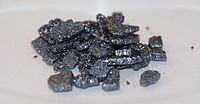
Photo from wikipedia
Allergic diseases have been one of the leading causes of chronic disorders in the United States. Animal studies have suggested that exposures to perchlorate, nitrate, and thiocyanate could induce allergic… Click to show full abstract
Allergic diseases have been one of the leading causes of chronic disorders in the United States. Animal studies have suggested that exposures to perchlorate, nitrate, and thiocyanate could induce allergic inflammation. However, the associations have not been examined among general populations. Here, we investigated data of 7030 participants aged ≥6 years from the National Health and Nutritional Examination Survey (NHANES) 2005-2006. Urinary levels of perchlorate, nitrate, and thiocyanate were measured by ion chromatography combined with electrospray tandem mass spectrometry. Information on allergic symptoms (hay fever, allergy, rash, sneeze, wheeze, eczema, and current asthma) was collected by questionnaire. Allergic sensitization was defined by a concentration ≥150 kU/L for total immunoglobulin E (IgE) levels. The associations were estimated using multivariate-adjusted logistic regression models. A positive association was observed for urinary nitrate and eczema (p < 0.001 for the trend). Compared with quartile 1 (lowest quartile), the odds ratios of eczema with 95% confidence intervals [ORs (95% CIs)] from quartiles 2 to 4 were 1.72 (95% CI, 1.41, 2.09), 1.94 (1.53, 2.47) and 2.10 (1.49, 2.97) for urinary nitrate. In addition, urinary thiocyanate was positively related to sneeze (ORQ4 vs. Q1: 1.25, 95% CI: 1.01, 1.55; p = 0.015 for the trend). However, urinary perchlorate was not correlated with any allergic-related outcome. Additionally, the associations were different among subgroups in a four-level polytomous model. Thus, our results suggested that exposures to nitrate and thiocyanate may be associated with allergic symptoms. Further investigations are warranted to concentrate on the practical strategies to monitor exposure levels and the latent mechanisms of the relationship between exposure and allergy.
Journal Title: Environmental pollution
Year Published: 2021
Link to full text (if available)
Share on Social Media: Sign Up to like & get
recommendations!